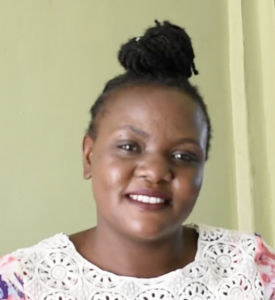Please note: original photos were taken before the COVID-19 pandemic.
The Bukalama area is rocky, and as you proceed toward Wanzetse Spring the land becomes steep. The predominance of farmland and vegetation in this village adds to its greenness and the cool environment.
Although there are 280 people who depend on Wanzetse Spring for all of their daily water needs, the spring water is not safe for consumption. At one time it was partially protected, but the work was not done to standard and it has since eroded. All that remains is a small outcropping of cement and the metal discharge pipe that was once part of the headwall.
Community members have improvised a banana leaf to act as a pipe to connect the standing cement to the spring's source - otherwise, there is a gap several feet long. But the banana leaf is directing water that is open to the surface, and mud and sand inevitably get mixed into the water. Sometimes children tamper with the banana leaf too, disrupting others' ability to draw water until a new leaf can be fitted to the pipe.
Whatever the scenario, drawing water from the spring is difficult and time-consuming. The makeshift discharge pipe system does not catch all of the water the spring produces, slowing the spring's yield time. All of this leads to crowds at the spring, which are especially concerning during the pandemic when community members are trying to avoid groups and limit their time spent in public.
Community members report that both adults and children often become sick after drinking the spring water.
"The water is contaminated. Most of us have been affected by stomachache because of drinking unclean water," said 33-year-old Davis Inzofu, who works as a graphic designer in the area. He added that cases of typhoid persist in the area among families who depend on this spring.
The access point is another area of concern. "The way towards the spring gets slippery when it rains, and it is hard for you to draw water," reported teenager Juliet. There are no stairs leading to the spring, but instead a slick mud path riddled with stones.
What We Can Do:
Spring Protection
Protecting the spring will help provide access to cleaner and safer water and reduce the time people have to spend to fetch it. Construction will keep surface runoff and other contaminants out of the water. With the community’s high involvement in the process, there should be a good sense of responsibility and ownership for the new clean water source.
Fetching water is a task predominantly carried out by women and young girls. Protecting the spring and offering training and support will, therefore, help empower the female members of the community by freeing up more of their time and energy to engage and invest in income-generating activities and their education.
Training on Health, Hygiene, COVID-19, and More
To hold trainings during the pandemic, we work closely with both community leaders and the local government to approve small groups to attend training. We ask community leaders to invite a select yet representative group of people to attend training who will then act as ambassadors to the rest of the community to share what they learn. We also communicate our expectations of physical distancing and wearing masks for all who choose to attend.
The training will focus on improved hygiene, health, and sanitation habits in this community. We will also have a dedicated session on COVID-19 symptoms, transmission routes, and prevention best practices.
With the community’s input, we will identify key leverage points where they can alter their practices at the personal, household, and community levels to affect change. This training will help to ensure participants have the knowledge they need about healthy practices and their importance to make the most of their water point as soon as water is flowing.
Our team of facilitators will use a variety of methods to train community members. Some of these methods include participatory hygiene and sanitation transformation, asset-based community development, group discussions, handouts, and demonstrations at the spring.
One of the most important issues we plan to cover is the handling, storage, and treatment of water. Having a clean water source will be extremely helpful, but it is useless if water gets contaminated by the time it is consumed. We and the community strongly believe that all of these components will work together to improve living standards here, which will help to unlock the potential for these community members to live better, healthier lives.
We will then conduct a small series of follow-up trainings before transitioning to our regularly scheduled support visits throughout the year.
Training will result in the formation of a water user committee, elected by their peers, that will oversee the operations and maintenance of the spring. The committee will enforce proper behavior around the spring and delegate tasks that will help preserve the site, such as building a fence and digging proper drainage channels. The fence will keep out destructive animals and unwanted waste, and the drainage will keep the area’s mosquito population at a minimum.
Sanitation Platforms
At the end of the training, participants will select 5 families that should benefit from new concrete latrine floors called sanitation platforms. Training will inform the community and selected families on what they need to contribute to make this project a success. They must mobilize locally available materials, including bricks, clean sand, and gravel.
The 5 families chosen for sanitation platforms must prepare by sinking a pit for the sanitation platforms to be placed over. Our trainers then instruct them on how to build superstructures over their new platforms. These 5 sanitation platforms will serve as examples for the rest of the community to replicate.
All community members must work together to make sure that they continuously provide accommodations and food for the work teams throughout all stages of spring and sanitation platform construction.

 Protected Spring
Protected Spring
 Rehabilitation Project
Rehabilitation Project














































